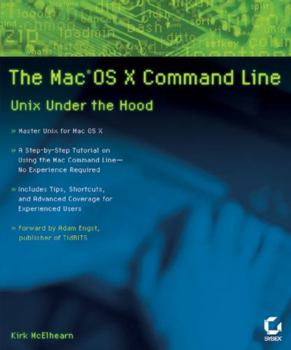The Mac OS X Command Line: Unix Under the Hood
Select Format
Select Condition 
Book Overview
The Mac command line offers a faster, easier way to accomplish many tasks. It's also the medium for many commands that aren't accessible using the GUI. The Mac OS X Command Line is a clear, concise,... This description may be from another edition of this product.
Format:Paperback
Language:English
ISBN:0782143547
ISBN13:9780782143546
Release Date:December 2005
Publisher:Sybex
Length:438 Pages
Weight:1.68 lbs.
Dimensions:1.0" x 7.5" x 9.3"
Customer Reviews
3 ratings
This book is more for Unix novices
Published by Thriftbooks.com User , 17 years ago
I found 2 chapters to be very useful, Chapter 12 on Working with Users, Groups and Permissions and Ch. 14 on Managing Programs and Processes. The remaining chapters are pretty much standard Unix commands; but, very well written for Unix novices. Overall the book is well written that I would use it as a Unix reference for commands that I am familiar with (example, didn't know ls -F would show me the directories with a slash).
Mostly good stuff
Published by Thriftbooks.com User , 19 years ago
Structured in a distinctive but helpful way, "The Mac OS X Command Line: Unix Under the Hood" is quite a solid introduction to the command line, a mechanism that not only speeds and simplifies many tasks but also lets you do a number of things unavailable under the GUI. Its 400+ pages, arranged fundamentally as a tutorial, are replete with basic steps and shortcuts alike. The book covers everything from Terminal ("gateway" to the command line) to the file system to text editing and printing; in the later chapters, it moves on to such relatively advanced topics as file compression and archiving, groups and permissions, networking, program and process management, system maintenance, and shell configuration. Interleaved between the chapters (and here is where the book's structure is distinctive) are sections devoted to key Unix concepts that recur to the point of transcending multiple chapters; these nine sections, referred to as Interludes, tackle things like command syntax, pathnames, redirection, the "open" command (more powerful than it may sound), wildcards, and ways of automating commands. Besides obviously providing a nice treatment of the basics, the book offers plenty of advanced material for the experienced user. The index is nice to see and easy to use. Other nice touches are a command list, chapter summaries in the introduction, and an appendix with additional readings. Allowing for a variety of problem areas, in large measure evidently outside the author's control, this is a book well worth reading and using. It is true that some of the editing errors are thoroughly confusing (references to subsequent material as supposedly already presented, references to misidentified chapters, related graphics positioned out of logical order, and so on); still, the book is redeemed by the readily understood and applied, comprehensive, and mostly well-organized content. Chuck Brandstater
Clear and easy to follow
Published by Thriftbooks.com User , 19 years ago
As anyone who's used one of Kirk McElhearn's other books on the Mac OS will be unsurprised to hear, I found this book very easy to follow -- so easy in fact that I found I could skip the first few chapters. That's probably because I'm not a complete command-line virgin (I remember the days before Windows and the first Mac OS, and as a web designer I've done a bit of tinkering in Unix on some of the web servers I use) but even if you are, from my impression of the first chapters, this book can tell you everything you need to know to start using the command line. The book is designed as a chapter-by-chapter tutorial, teaching you the things you need to know in a methodical order, but it contains enough information, and has a good enough index, to be used as your main reference for the command line once you've mastered the basics. My only criticism would be that while it tells you how to do all sorts of useful things, it doesn't have enough real-world, detailed examples of the kind of uses you could put your new knowledge to -- I was expecting some kind of 'case studies' feature, giving real examples of how to use commands you've just learned to automate your back-up procedures, for example. The information's all in there, but to some extent you have to work out what you can do with it for yourself. But I guess that's only a minor criticism -- you probably wouldn't read this book in the first place if you didn't have some idea of the kind of thing you can do with the command line. So all in all, it's a great starting point, and I can see that in the future I'm going to find it a valuable reference.






